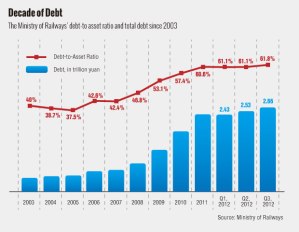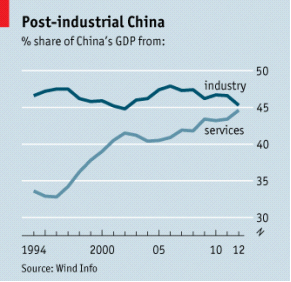A new state railway company will take care of the debt of China’s former Ministry of Railways but will receive various forms of state backing, as Chinese officials begin restructuring the China’s vast but troubled rail system.
Huge debt issue
Since the Ministry of Railways had accrued a total debt of 2.66 trillion yuan (US$426 billion), compared with its total assets of 4.3 trillion yuan (US$689 billion) at the end of September, how this debt will be paid off had become a hot topic of discussion.
The ministry’s debts have soared since 2008 when disgraced former minister Liu Zhijun mounted campaigns to develop a network of high-speed trains. It has borrowed heavily through bonds to finance construction and service old debts.
The sheer size of the debt – 2.66 trillion yuan by the end of September – has made it impossible for any company to absorb the loss on its own. So here comes our concern: how to cope with the staggering debt?
Private financing
Private financial investment into the new railway management authority will be a welcome addition, and will reduce public expenditures on building and maintaining the country’s railways.
China is looking towards attracting private investments and reducing the financial burden such improvements place on the government. The government’s new proposals appear to strike a reasonable balance between new financing options and the need to retain control of the country’s infrastructure. However, if the current reforms are successful, pressure will undoubtedly grow to increase the role of private financing.
In Germany and France, there is heavy state input to ensure the viability of the network, which is what China is trying to reduce. In Britain, where the government has concentrated heavily on outsourcing to private contractors, the results have been particularly unpleasant; the essence of the problem is that, though operations and costs can indeed be outsourced, it is not in fact possible to transfer risk and responsibility to the extent that the government would wish (a fact that the Chinese government has acknowledged by retaining overall control).
Attracting investment from social capital and private investors is what the former ministry have been trying to do in order to push forward the separation of corporate from government management. However, it is faced with severe difficulties because of the following reasons.
Since private investors care about the return of investment,they don’t exhibit much initiative and enthusiasm investing in the railway. This is because railway construction and operation has huge demand for capital, long investment cycle and long payback period. Besides, compared with tremendous investments with billions of capital injected, private investment is relatively small in size. For the above reasons mentioned, it is indeed difficult for reforming the financing sources of the railway.
suggestions:
The multiple investors railway Development Fund can be an effective way to attract investment of social capital in order to further broaden the financing channels of railway construction, under the premise of ensuring the state-owned holding and unified operations management. Through the sale of equity, the role of the Fund is to enable private capital to purchase preferred stock as a method of investment. Private capital investment platform can be established if the fund is able to play a critical role.
From our point of view, the establishment of the Railway Development Fund is significant, since it will be a breakthrough, and the starting point of the railway investment and financing systems and it will help build private capital investment platform. Recent reform ensures separation of enterprise from government would make the Development Fund more attractive.
Government funding
Like other developed countries like US and other European countries, the railway debt is likely to be government funded, which has been scolded by various citizens for the tax they paid are the main source of fiscal spending by the government.
If we look at the bigger picture, we may be astonished to find that nearly all the state government has to provide financial aid for covering the costs of railway construction and operation. Deficit is not unusual for railway industries. Even in France where the most developed trains locate, over 50% of construction costs were government subsided. So we may come to realize the necessity of government payment.
But is it reasonable for government to pay for the debts? Our group members deem it reasonable and sensible. Since railway industry is domestic investment projects with huge dimensions and money injections, we cannot treat them as traditional operating enterprises. Besides, the difficulty of private financing is conspicuous due to state control and monopoly private finance will create previously unknown demands for increased profit. As we know from the Western experience, this will sometimes be difficult to reconcile with railways providing a public good.
From the perspective of a whole country’s welfare, despite the huge debt, China’s transportation authorities have until now provided admirable service to the Chinese public, and the growth rate of the national infrastructure is a wonder of the modern world. The economic benefits and externalities that the railway provided are priceless. Because of this, the railway construction is not based upon profit-aimed motives and it is thus reasonable for the government to fiscally subsidize the railway construction.
What should the government do indeed?
We could refer to the coping mechanism of exchange the debt owed to the commercial banks with newly issued government debt. After the shift, commercial banks become the holder of national debt, and railway debt belongs to fiscal authorities of the state council. And the fiscal authorities can transform the debt to equity by absorbing shareholders like the State Asset Administration Committee. And for commercial banks holding national debt, they can sell it to the central bank of China so that the national debt is redirected into monetary base through central banks open market operations. This method is more publicly accepted than directly injecting money from the central bank to the railway system to reinforce the capital of Ministry of Railway, because people tend to accept issuing currency.
Apart for the remaining debts, we suggest speeding up the marketization of railway industry and thus encourage the state rail way company to finance its debt by IPO and other equity financing methods. Even though the IPO might not be approved in a short period of time, private financing could ease the debt situation with marketilization.
Reflections on the issue
The first reflection: Perhaps the debt of railway can be solved through monetary injection. However, accepting the growth and the expansion of the real economy in the national currency area is a prerequisite for this injection. If your national currency is the world currency, you can import other countries’ equipment and technology of high-speed rail service in high price through print dollars, which belongs to the cost of occupying another country. However, when your country’s currency is not the currency of the world, the equipment and technical services being purchased must come from their own country. Otherwise, the Taiwan High Speed Rail Mode needs to be abandoned.
The second reflection: the existing unreasonable factors of real. Many people say government and corporate unity is the most fundamental reason for China’s high-speed rail debt crisis. However, we believe that the root cause is not this. There exist negative precedents for high-speed rail projects in Hong Kong, China, Vietnam and India. However, things will be different in China. The passenger line which involves trillions of investment in large-scale of high-speed and high standards can be commenced without being selected seriously from different railway construction programs, even without being approved by the NPC.
This not only causes the debt problem, but also leads to the uncertainty of railway development direction. For example, China’s railway freight has become a major bottleneck now. China’s railway freight volume proportion of the total social freight turnover is only equivalent to 50% of the United States. And this serious unreasonable transportation structure brings to a lot of distortions in the Chinese economy.
We need introspection of the condition that China’s high-speed rail construction of large scale and high standard is being paid attention to only after huge losses. The Minister of Railways who assumed office in 2003 immediately shelved the original reform and refused to break the railway monopoly. He put the one-sided pursuit achievements of passenger line construction on the first place. Now we begin to carry out market-oriented reforms. We do not want to see a huge debt or other problems before they cause everyone’s attention. Indeed, the railway reform has a long way to go.







